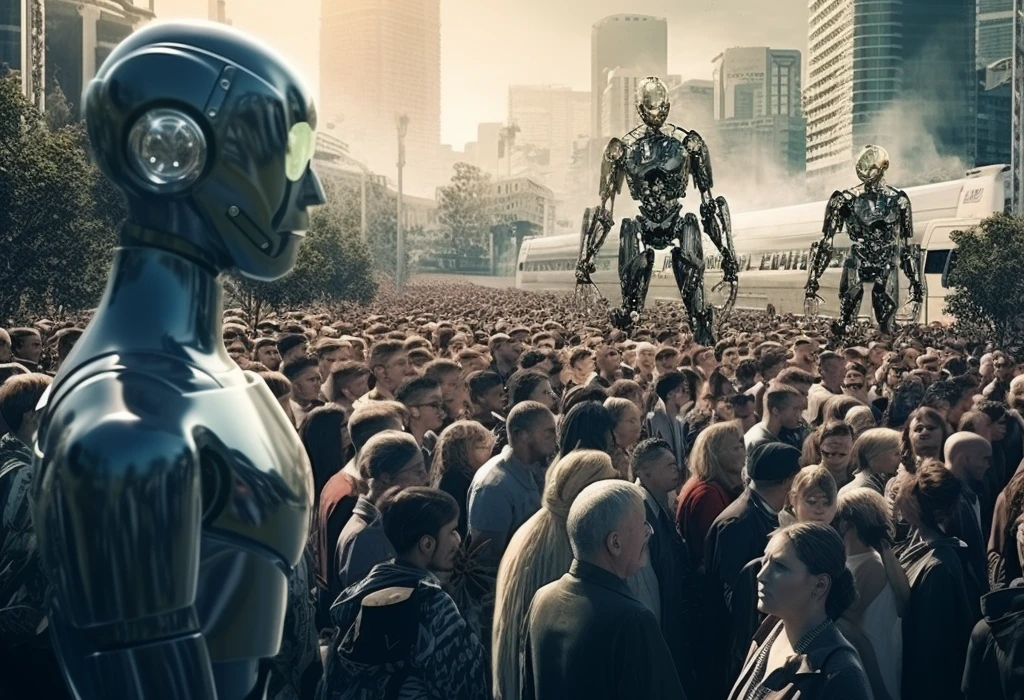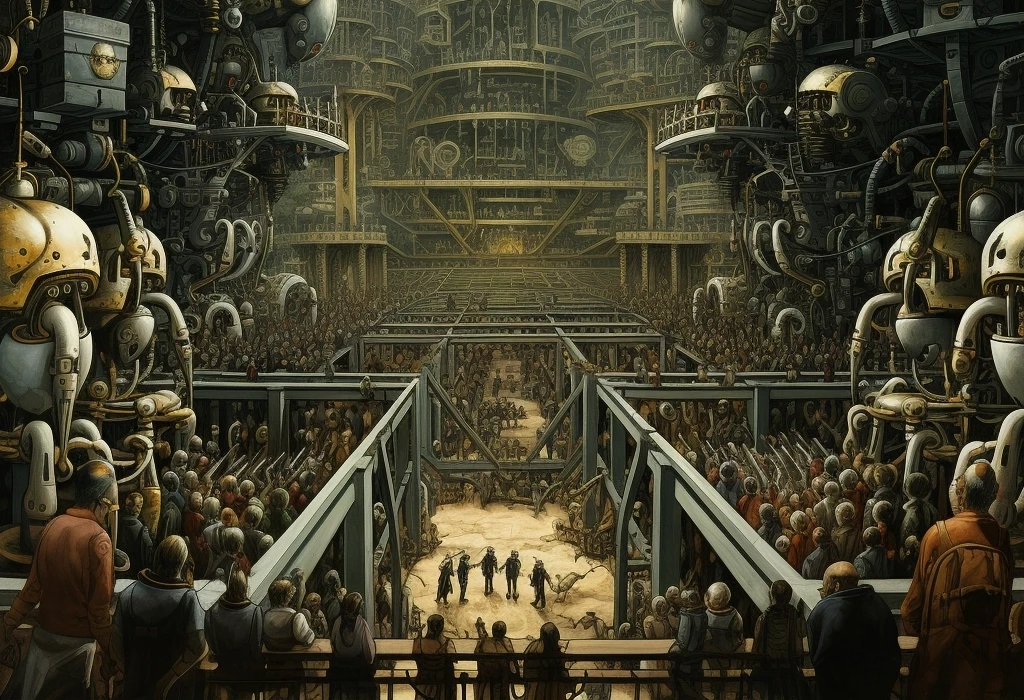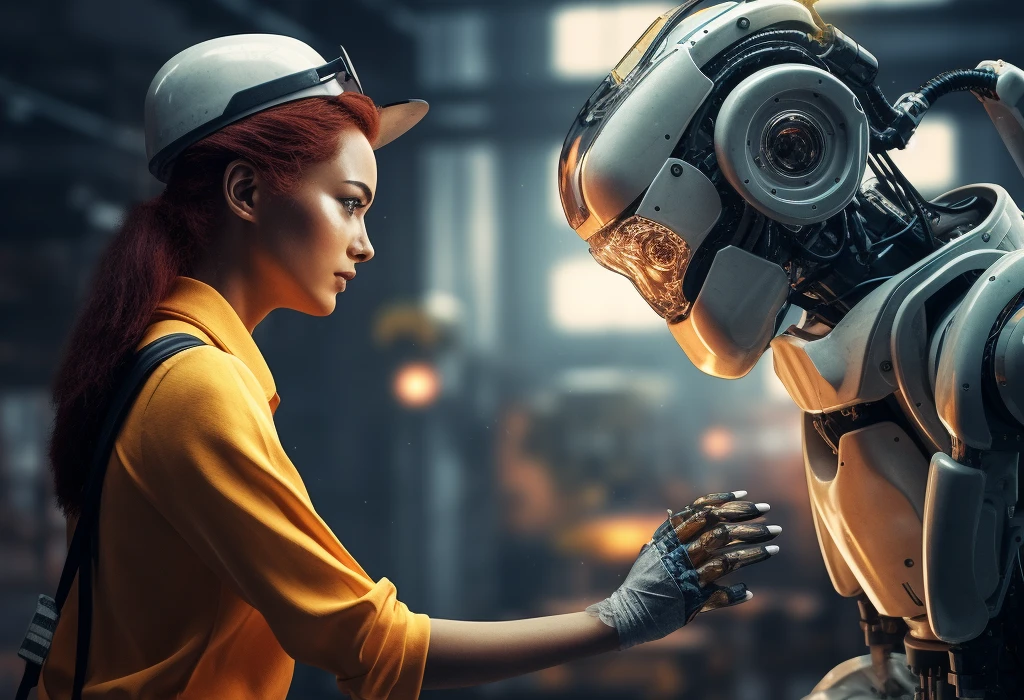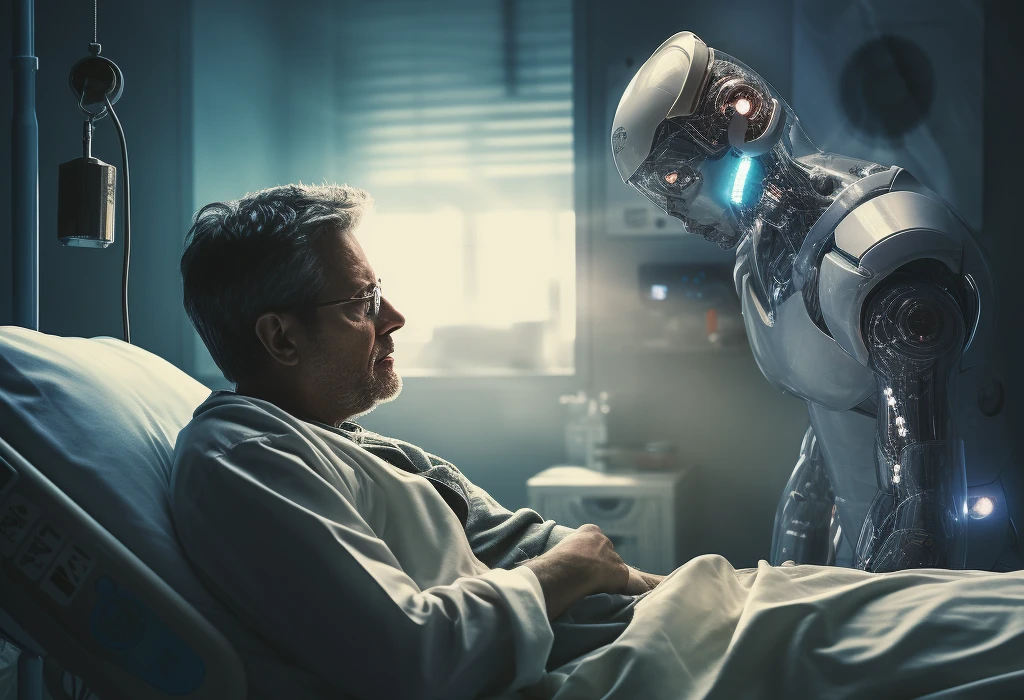The age of Artificial Intelligence (AI) and automation has arrived—an age where we can see the machines we have created grow smarter and more capable by the day. Their skills not only match but surpass, those of their human counterparts in many ways. It has brought about innumerable benefits to the world, from automated assistants to self-driving cars.
However, there’s an uneasiness casting a shadow over the labor market as automation replaces human jobs at a rapid pace. Does this technological revolution herald the end of traditional human employment? Are we on the brink of being replaced by our inventions?
“Machines don’t fall ill, they don’t need to be isolated to protect their peers, they don’t need to take time off work.”
These words aren’t mine! They belong to Daniel Susskind, a professor of Economics at King’s College London, who penned the popular book “A World Without Work: The Challenge of Automation, and How Should We Respond?”, and he’s even the principal investigator at the Institute for Ethics of Artificial Intelligence at Oxford University.
And yes, guys, there is a whole institute in Europe for the ethics and values of artificial intelligence. Interesting, right?
In this Article, We will explore and try to answer some questions that go viral whenever advancements in artificial intelligence or machine learning are made. Questions that Professor Daniel and countless others are trying to answer and that concern the entire world:
Will AI Replace Human Jobs? Will Intelligent Automation lead to job losses? Will robots take over the future of work? Let’s delve into these pertinent questions together.
Related Article: Artificial Intelligence vs Human Intelligence.
The Robots Are Coming

Sounds like a science fiction scenario, doesn’t it? But, nope, this is real life! Take Amazon, one of the big guys out there. This past January 2023, they said “see ya later” to 18,000 employees.
In an interview with CNBC, Cathie Wood, who heads Ark Invest, dropped the bomb that Amazon is welcoming a thousand robots into its fold every single day. They’ve already got more than half a million of these mechanical workers! Cathie’s crystal ball predicts that by 2030, robots at Amazon will outnumber humans.
In this context, we must ask some critical questions: Do such processes apply to everyone, or are they just fancy things for the leading companies?
If so, and the threat of replacing human jobs with AI is real, how could this scenario happen in the future?
What jobs will be replaced by AI?
Does this threat affect all professions?
What would the labor market be like if these AI technologies take over our jobs?
How can we as individuals prepare for the AI revolution?
These are just a few of the important and exciting questions that we will be discussing right here. Time to dive into the realm of automation and artificial intelligence that could make us unemployed.
Industrial Revolution: The Start of our fear of Automation

The idea of automation taking over our jobs isn’t a new phenomenon. Nope, it’s been a hot topic since way back in 1589. That’s when William Lee (he was an English clergyman) invented the first mechanical knitting machine, called the Stocking Frame. He gave Queen Elizabeth I a pair of black stockings, fresh off his machine. But the queen didn’t give him a patent for his invention. She didn’t like his wool stockings. And what worried her more? The machine might take jobs from her people!
Therefore, we will find that the protests of British textile workers and French silk manufacturers against the emergence of textile machines at the beginning of the 19th century were among the distinctive features of the European industrial revolution.
This demonstrates that the fear of machines replacing humans is an old concern, recurring throughout history, especially in the 20th century, which witnessed many major transformations in terms of job automation. Also, more calls appeared warning about how machines would replace human labor.
Perhaps the most significant waves of automation occurred after World War II in the 1950s and early 1960s, when many factories began to automate and lay off workers, led by Ford’s engine plant, which was transformed into an almost fully automated plant in Brook Park, Ohio, causing tens of thousands of workers to lose their jobs.
This structural transformation led to the US economy entering a big depression, historically known as the “Automation Depression”. At that time, US President John Kennedy made a statement declaring that automation is the biggest challenge for jobs.
The Brighter Side of Traditional Industrial Automation
So, was the automation during the industrial revolution really that bad? Honestly, it might have been like this at the beginning, but what followed painted a different picture.
Looking back, every technological revolution, from the advent of machinery in the Industrial Revolution to the rise of computers in the Information Age, initially spurred fears about mass unemployment.
However, over the long term, the total number of human jobs these innovations have created is far better than those taken over and lost. Some of those jobs are completely new jobs that didn’t exist before the advent of these automation technologies. and this is what we will discuss later in another historical example of the impact of computers during the third industrial revolution.
Now let’s jump into the current new wave of automation led by AI.
AI Revolution: ChatGPT is just the beginning
I have been recently having fun chatting with something called ChatGPT, which many of you know and may have tried. For those who don’t know what ChatGPT is:
ChatGPT is, in short, a machine that chats like a human! It’s an AI-based text generator, or AI chatbot, developed by OpenAI and trained on a massive array of internet texts. Users simply need to ask questions to the chatbot, and it comes up with (most of the time) accurate and mind-blowing answers.
It’s been free to use since November 2022, and a paid version called ChatGPT Plus was launched in February 2023.
Erik Brynjolfsson, a professor of economics and information technology at Stanford University and co-wrote of ‘The Second Machine Age,’ told Bloomberg at the World Economic Forum in Davos that ChatGPT could wave goodbye to routine work, enabling more creative tasks. He doesn’t see this technology replacing thought or writing, but rather, like a calculator simplifying math, it could enhance our writing ability, he expects ChatGPT to “augment our ability to write.”
With immense curiosity, I attempted to test the capabilities of ChatGPT and asked it to write this article!
However, the results weren’t up to par and weren’t worth publishing. It still can’t match the creative and personal touch of human writing. Thus, I decided to simplify things and pose a series of questions on various topics to gauge the quality of the responses.
Yet again, the responses lacked originality and creativity; they seemed like answers from a machine that was full of facts. Plus, let’s not forget that sometimes AI’s answers can be useless, give the wrong answers, or just be nonsense. Guess we still win in the writing department! (At least, that’s what I experienced.) Perhaps I need to improve the way I prompt or interact with ChatGPT!”
ChatGPT takes over Copywriting Jobs

Despite what’s been mentioned above, some companies are turning to AI tools like ChatGPT due to their cost-effectiveness, even if it means compromising on quality writing. This raises the question: Can AI replace copywriters, and take over content creation and human creativity at some point in the future?
Well, perhaps the wave of replacement has already started. For example, according to The Washington Post, Olivia Lipkin, a copywriter replaced by ChatGPT, is reconsidering office work altogether and has started a job as a dog walker. This reflects how some workers are pushed to switch to alternative jobs outside their original field or even face unemployment.
Will AI replace Human Jobs?
The short answer is Yes! however, It is a complex question that has sparked quite a debate between two main groups. Let’s take a closer look!
The first group is the technological team: recently, more than 1,000 technology leaders and researchers have signed an open letter to pause AI development for six months. Silicon Valley leaders like Elon Musk and Bill Gates have very dim opinions, and their viewpoints always take that approach:
What Tech Leaders’ saying about the Risks of AI
- People should prepare; robots and artificial intelligence will take over their positions.
- Unemployed forever: AI Technology not only makes plenty of people unemployed, but it also makes a large percentage of those people unemployed forever. Their experiences, education, and qualifications are quite far from the appropriations of the labor markets, which acquire different and high qualifications for those unemployed.
- From Blue to White: The tech leaders raise an even more significant concern, unlike the previous waves of technology, which mainly affected the blue-collar jobs of unskilled and skilled workers, the next wave will also affect the jobs of white-collar office workers. In other words, the jobs of doctors, engineers, lawyers, and even managers could be taken over by robots. They are no longer safe.
Elon Musk, according to CNN in a recent interview, has shared some pretty intense concerns about artificial intelligence, even warning that it could lead to “civilization destruction.” Despite his involvement in AI growth through his businesses, he has increasingly warned about its risks. He also supports government regulation in this field, believing that without it, AI may become uncontrollable.
And that’s just a glimpse into what some of the tech titans are saying.
Economists’ Perspective on AI and Job Loss
The second group is the economists, those profound intellectuals who hear the technicians’ warnings everywhere, but don’t agree with them, as they think that this is not the first time that we witness warnings and fear that machines take over human jobs, as we mentioned above.
Well, why are economists calm and optimistic? Can we expect AI-Led Automation to follow the same pattern as previous traditional industrial automation?
Lessons from History: From Sundials to Smartphones
let’s go back in time for a bit to get a better grip on what economists are saying. History shows us that while tech can change the kinds of jobs we do, it ends up creating more jobs than it takes away! Remember when farming got a major upgrade with the introduction of combine harvesters? when clocks nudged out sundials? Heck, even candles lost their job to electric lights!
Now, let’s take another example of computers and the Internet. According to the McKinsey Global Institute, when these wonder machines first appeared, they destroyed about 3.5 million jobs in the U.S. since 1980. Jobs like accountants, secretaries, and typists – they all took a hit. But stick with me; the story gets brighter…
How does technology create more jobs than it destroys?
Sure, computers displaced many jobs, but they also sparked the creation of millions more! Think of roles in hardware manufacturing, software and app development, e-commerce, and jobs that wouldn’t exist without computers, like call-center reps. In numbers, the PC and Internet era has brought about 19 million jobs, a net gain of 15.8 million since the 1980s. Today, 10% of jobs are directly linked to this technology. So, automation might bring changes, but also new jobs we can’t even imagine yet!
As we have seen in previous historical examples, the emergence of any new technology works to rearrange the labor market again by eliminating some old jobs and opening the door to new jobs related to this new technology. But this is only one side of the story.
More jobs, Better Profits, and more Free Time
The main reason we adopt new technologies is that we want to amp up productivity. Productivity means how much cool stuff each worker can produce in an hour. So, if a factory or any industry can boost its productivity with technology, it’s a big win. Why? Because with this increase, they can spread their wings, grow bigger, and hey presto, create new jobs!
Increasing productivity also means higher wages for workers and lower prices for commodities, meaning that purchasing abilities will be greater, and thus new production cycles will be needed to meet the demand for commodities.
So, new technology creates more jobs, better profits, and so on. It also means less working time and more free time.
In countries like the U.S. and Europe, people are working way less than they used to a hundred years ago – in fact, about 50% less each week. Plus, paid vacation days have increased, and even the number of part-time workers has also increased.
Who should we believe now?
So, where does this leave us? The tech leaders, who keep telling us things are getting worse, or the economists who consider that it is not that dim and that we will find better jobs with better wages and fewer working hours?
Honestly, we need to be listening to both sides. Here’s why.
If we flip back through the pages of history, it does seem like the economists have a point. Past automation revolutions did turn out pretty awesome in the long run. But hold up! We shouldn’t brush off what the tech experts are saying – that this AI-powered automation wave is different and could be the most challenging one yet. They have some solid reasons to back up their concerns, too.
Intelligent Automation: Machines Beyond Manual Labor

When we talk about machines today, we’re not just referring to the traditional factory machines and devices, those doing repetitive manual labor like in the past. No, we’re talking about intelligent machines that can learn from massive databases, drive cars, fly planes, trade stocks, diagnose some diseases, help out with prescriptions, and even have fluid conversations with very high efficiency.
So, we’re looking at a potentially larger scale of job displacement, across more diverse fields than we’ve ever seen during past periods of automation.
In general, the jobs that will be replaced by AI and automation will not only be tens or even hundreds of thousands of factory workers or people with regular jobs, but also the jobs of millions of skilled professionals—engineers, accountants, financial service providers, health care providers, and so on. Most of these already have university degrees with years of experience.
Based on my experience in this field, I’ve seen just how quickly technologies critical to artificial intelligence and machine learning have evolved. Things like central processing units (CPUs), hardware accelerators such as graphics processing units or GPUs, and tensor processing units or TPUs (you might’ve heard of NVIDIA H100 and A100 AI-focused GPUs) are progressing at lightning speed. What we expect today could flip completely—by a full 180 degrees—even as soon as next year!
In 2004, for example, there was a prestigious study predicted that artificial intelligence would never be able to understand human speech and language to communicate with them.
Of course, I do not need to tell you now what happened to that study, as currently each one of us has a complete AI voice assistant on his phone. Such as Siri for iPhone and Google Assistant for Android phones. We can just talk to them, ask them anything, and they understand and respond. So much for that prediction, huh?
New Technologies may not offer new jobs as in the past
Well, how many of us can confidently say that this new wave of technology, especially the rise of artificial intelligence, will create new job opportunities like past automation revolutions did? Let me give you an example of Blockbuster, the American movie and game rental store.
Blockbuster was at the peak of its success in 2004 when the company had more than 84,000 employees in more than 9,000 stores around the world and achieved revenues of about $6 billion.
But fast forward to 2010 and the picture wasn’t so rosy. They filed for bankruptcy. Why? They couldn’t keep up with the market changes. The era of popping out to rent a movie was over and the time of binge-watching shows on platforms like Netflix was in.
Thus, the streaming giant, Netflix, stood up over the ruins of Blockbuster, reaching 31.6 billion dollars in revenues in the year 2022 alone. And how many employees did Netflix acquire? Only about 13 thousand employees. That’s more than five times Blockbuster’s earnings using almost one-sixth of the number of Blockbuster’s employees at its peak.
This means that new technology may not create job opportunities as much as the jobs it displaced. In addition, the ratio between the profits generated by these new technologies and the number of jobs they provide is decreasing over time. Sure, innovations can improve our lives, raise productivity and enhance efficiency, but they rearrange the labor market and work on transforming it, raising some wages and decreasing others, and there is no guarantee that enough jobs will be created.
What jobs will AI replace?

So, Which jobs will be replaced by AI? Well, to find out, we really need to look at the impact of automation, taking into account the expected advancements in AI and robotics. So, let’s take a look at some of the key research and analysis that may shed some light on the upcoming wave of job displacement due to AI:
Jobs Threatened by AI: A PwC Study Perspective
There was this eye-opening study back in 2017 by PricewaterhouseCoopers, a big name in the consulting business. What they found was a little alarming. Their analysis suggests that by 2030, a hefty chunk of jobs in some major economies could be at risk due to automation. We’re talking 30% in the UK, 38% in the US, 35% in Germany, and 21% in Japan. Yeah, you heard that right!
So, how did PWC experts identify jobs and sectors at risk? Well, They broke down the duties of each job into five main categories: Manual tasks, Routine tasks, Computation, Management, Social skills, and Literacy skills. By analyzing and comparing these categories with what AI can do, they were able to predict the percentage of automation for each job.
As we see the impact of automation on the job market is complex and varies by industry, job type, and country. In general, jobs that involve any manual, repetitive, or computational tasks that can be easily performed by machines are more at risk, while jobs that require human skills such as creativity, management, and social interaction are less likely to be automated.
Diving Deeper: McKinsey’s Perspective on Job Automation
In a more recent and slightly detailed report by McKinsey in May 2018, titled “Skill Shift: Automation and the Future of the Workforce“, they dug a little deeper into the same concept. Their researchers identified 25 skills that were necessary for the job market and grouped them into five key abilities: physical and manual skills, basic cognitive skills, higher cognitive skills, social and emotional skills, and technical skills. The study then analyzed the total work hours required for each skill type in 2016 and predicted what they’d be by 2030.
The results were not shocking – roles primarily based on manual labor or basic cognitive skills faced the highest risk of automation. Meanwhile, roles that required communication, social interaction, or technical skills would not only remain safe but also see a significant increase in demand.
The Decline of Manual Labor by 14% in 2023
For instance, in 2016, workers in Europe and America spent 203 billion hours on physical and manual tasks. This number is projected to shrink to 174 billion hours by 2030, a 14% reduction. This group comprises a wide variety of professionals like craftworkers, drivers, mechanics, food service staff, factory workers, security personnel, and more.
The Decline of Basic Cognitive Task Hours by 15% in 2030
When we consider basic cognitive tasks, such as cashiering, customer service, and data entry, the expected total work hours drop from 115 billion in 2016 to 97 billion by 2030, a 15% decrease.
Jobs that Maintain Stability through 2030
Interestingly, roles that require advanced cognitive skills, such as doctors, accountants, financial analysts, lawyers, writers, HR specialists, and even artists and musicians, will see a negligible increase in total work hours, from 140 billion to 151 billion hours by 2030. Their position remains relatively stable.
Jobs that are hard to replace with AI
Those with social and emotional skills are the lucky ones. As AI still has a limited understanding of these fields, professionals like managers, executives, teachers, business planners, sales and marketing representatives will see their total work hours increase from 119 billion to 148 billion, a 24% hike.
Jobs that AI can’t replace
The luckiest of all are those with technical skills. Application developers, network specialists, advanced data analysts, engineers, and robotics and AI experts will see their total work hours increase from 73 billion hours to 113 billion hours by 2030, a whopping increase of approximately 55%. These roles seem to have the brightest future in the age of automation.
How Do AI and Automation Impact Different Countries?
Ever wondered why AI’s impact on jobs seems to vary from one country to another? Like why it’s different for the US, UK, Germany, China, and Japan? It’s a bit complex, but it really boils down to the specific nature of each country’s economy. It’s kind of like each country has its own unique AI ‘fingerprint’.
For example, industrialized economies like Germany and Japan have different automation needs than service-based economies like the United States and Britain. Moreover, even within similar economies, the same sector can behave differently due to various factors.
Let’s consider the financial services sectors in the US and UK. The PwC study we discussed earlier expected that the automation rate in this sector would hit 61% in the US, almost double the UK’s predicted rate of 32%.
This discrepancy stems from the unique composition of the sector in each country. In the United Kingdom, the financial services sector tends to have a higher average educational qualification compared to the US. This suggests that most British workers in this field are professionals dealing with global financial markets in London.
Meanwhile, in the United States, a large chunk of workers in the same sector operate at a lower, local level requiring fewer skills, making them easier to replace with AI.
The story isn’t too different for Germany and Japan either. Despite both being industrial economies, the capacity for automation in Germany’s industrial sector surpasses Japan’s. Why?
Japanese workers typically perform fewer manual tasks compared to their German counterparts.
In developing countries, the transition to automation will likely trail behind that of major economies like the US, UK, and Germany. This doesn’t render them immune but could potentially give them a longer grace period to adapt to changes.
Conclusion
Wrapping up, automation is a dual-faced entity. Yes, it’s led to job losses in certain sectors, But let’s not forget the brighter side – automation has also been a job creator. It’s opened up avenues in tech, programming, and robotics, and even spurred the birth of new industries and businesses.
The full impact of automation is complex, hinging on factors like industry, job type, and geography. Jobs with repetitive tasks are more at risk, while roles requiring creativity and problem-solving remain less threatened.
You won’t get tomorrow’s job with yesterday’s skills!
Moreover, I’d advise you to prepare yourself for the AI revolution by acquiring skills that align with the evolving labor market. And for nations, being proactive in anticipating and managing the impacts of this transformation could be key to thriving in the AI-powered future.
Finally, if you enjoy this post? We’d love to hear your thoughts in the comments section below. Don’t forget to share this with your friends and followers! And remember, you can stay updated with our latest technology posts by following us on Twitter and Facebook.












